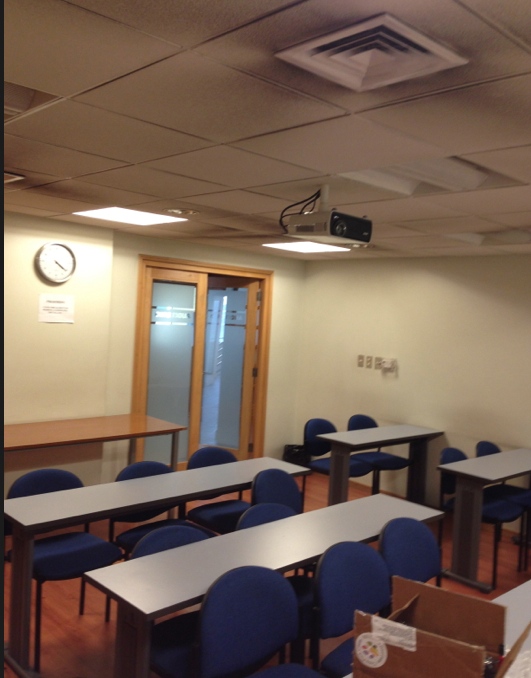I guess you could say the same for the taxi car company because the taxis are pretty much the same.
Then there are the cars that the carabineros drive complete with grills over all glass.
And this is what the carabinero station looks like -
There have been a number of other striking things, so it is time for Chilenismos 2. When we came into the country the guy stamping our passports didn't change the date and so the stamped date was wrong. Once in the country you have 30 days to go to the PDI central office and register your visa. This was a one hour plus wait. On Erin's temporary ID, the clerk entered the wrong date for Erin's visa expiration - so it looked like it expired before we entered the country. After 10 days we needed to go to the civil registry for the next step. After 150 minutes in two lines they decided that although Erin's visa, which she brought, had the correct date and the computer had the correct date, she had to go back to square one because the PDI clerk made a mistake. This means going quite a distance across town. I had the correct date, so got finger printed with nasty black ink and handed a paper towel after having may hands sprayed with something like Lemon Pledge - which doesn't take the ink off. Ok, the next week we go back to PDI and get Erin's temporary ID corrected. Then we go to the civil registry. Guess what? Yes, another of Chile's famous strikes. We saw this sign complete with black balloons and no idea when the strike would end (the postal strike lasted a month and resulted in an $80/month raise).
I wasn't totally disappointed because that meant that Erin didn't get the hand ink treatment and we could go to the best chicken place in Santiago.
I have previously mentioned that you often get a cash register printed receipt and a hand written one. Well, I went and signed up for a 10k run (it will be its own post as it was an adventure). I went in person because I don't have a RUT card. The civil registry has to 1) not be on strike and 2) not make mistakes on the paperwork every time you go.
The blue stamp is just that - this is official - my $3,000 peso entry ($6 USD) got me a hand written and hand stamped receipt. We often go down into Barrio Bellavista, and this is what it looks like. Lots of restaurants with tables on the sidewalks.
The red restaurant above had very good chow!
This was a warm day and a couple of the stray dogs decided the marble steps at the entrance to the school building were nice and cool. I've mentioned the dogs are smart - didn't know they went to school too!
There are a lot of palm trees in town and even some bamboo in people's yards.
You may notice the fence by the bamboo. Pretty much all the houses in the area have fences.
There are occasional basketball courts, but I have yet to see a basketball. These guys were playing soccer on the basketball court. About 5 seconds after I took the picture they accidentally kicked the ball out of the court and it started rolling down the hill. A guy on a motorcycle turned a quick u-turn and at about 30 mph kicked the ball backward so it didn't continue rolling down the hill. I was already chasing the ball as the court was fenced in. I grabbed the ball and the guy on the motorcycle turned a quick u-turn to make sure I got it. He was a Brit and yelled to me in an English accent something to the effect of good that the ball is safe. This illustrates many things: 1) soccer is pretty important in Latin America and England - why else would moto man go to the trouble. 2) there is at least one Brit in Chile. 3) if this were a basketball in the US, the guy on the motor cycle would have picked it up and kept going.
Every now and then you see a car that hasn't moved for months. This little number has grass growing through the tires. On the back is a for sale sign "en venta."
In an earlier post I mentioned the graffiti. Much of it is really more along the lines of art. Some of it is pretty abstract/surrealist - perhaps a mix between Picasso and Salvador Dali.
There are things that can tip you off as to how safe of a neighborhood you are in. For example, if they chain down all of the chairs and tables at an outdoor restaurant it is a pretty good clue that you need to watch your wallet. (click to zoom)
Huevos are a big deal here. A common dish is a steak with eggs on it. Erin thought this store was picture worthy - roughly translated - Eggs for better or worse. To the right is a large warehouse with many fruit stands. I decided against taking pictures inside.
One last thing to cover is that you can get hats of professional sports teams from the States. Check out the Chicago Deers hat second shelf from the top. (click to zoom)
If you look at the bills on the hats you can see they do have the authentication sticker. And you can also get one for your girlfriend so that she can be a styling fan as well.
Myself - I'm kind of partial to the hat on the bottom with ear flags. Actually, I have one kind of like it back home.
end of post

















































.JPG)

